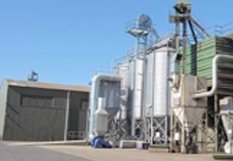 Full
FullGuide »
Great care must be taken in harvesting peas as a premium is often available for high quality produce. Quality can be affected by wet weather at harvest causing staining in a lodged crop. If destined for the packet trade, chip shop or export, value is reduced if pea seed is ‘bleached’ by the sun. If peas are left in the field too long until moisture content is 12%, or if they are over-dried, the crop may be unsuitable for human consumption, the percentage of 'non-soakers' increases and the seed may split and crack.
Peas can be combined when moisture content of the mature seed is 18% MC and higher quality seed and human consumption is often achieved by early combining at 18-20% MC followed by careful drying. This avoids damage to the seed coat, and the incidence of non-soakers.
If the peas are destined for animal feed they can be combined at moisture contents much lower than this, reducing drying costs. Harvesting at low moistures (e.g. less than 15%) the seed may split, but split peas are still acceptable for animal feed. However, harvesting at such low moisture contents may well significantly reduce the recoverable yield due to pod shatter and shelling out.
Determination of moisture content is a useful means of assessment of combining stage (25% or less), grain storage (14-16%) and long-term storage 14-15% MC.
Crops should be direct combined with a cereal combine wherever possible - and without pre-harvest weed management. This is practicable in a dry harvest, in a crop free from weeds and dying back evenly.
Most varieties of peas lodge to some degree before harvest although semi-leafless and stiff-strawed types are less prone to this. It is easier to harvest long-strawed varieties, and an even, adequate plant stand is an advantage.
Quality is reduced by soil contamination. Do not combine when there is surface moisture on the haulm, or when the soil is wet, and make sure the combine is clean.
It is possible for peas to pass through most combines without damage when the seed moisture content is about 20% and early harvesting at 18% avoids bleaching, shelling out losses and splitting or the deterioration in quality of human consumption or seed crops during wet weather. For animal feed, peas harvesting later when they are about 16% moisture content will reduce drying costs.
If the crop is very weedy, combining can be aided by killing any weeds present. Glyphosate is currently the only material to prevent further growth of weeds prior to harvest so that less troublesome and more effective combining can take place. However, it is relatively slow to work.
Moisture content of the pea seed should have fallen to below 30%. Treatment must be delayed until the peas on the least mature plants have reached the ‘starchy’ stage and can be marked by a fingernail and do not readily split. The top pods at this stage will be pitted and wrinkled while the lower pods will be at the parchment stage, and the foliage beginning to turn yellow.
After application, harvesting should be possible 10-14 days later, or a little sooner if weather conditions are favourable.
Note that glyphosate must not be used on seed crops.
Drying and storage for peas needs to ensure that quality standards are met. These are usually 14% moisture content and 2% impurities ex farm, or a combination of both, which should not exceed 16%.
The relatively large seed size of peas makes drying more difficult than with cereals. Whilst damaged peas are still acceptable for compounding, mouldy produce is not. Considerable care must be taken not to over-dry peas. For human consumption peas, the drying temperature should not exceed 49°C if the moisture content is below 24%, or 43°C if the moisture content is higher. At higher temperatures, a tougher texture or splitting of the grain may result. For seed peas, the temperature should not exceed 43°C if the moisture content is below 24%, or 37°C if the moisture content is higher.
When the moisture content is high, two dryings may be necessary with at least two days between to enable the moisture to spread evenly throughout the bulk.
Any type of dryer may be used for peas, but those operating at low temperatures are safer

For safe storage, the maximum moisture content of peas depends upon the method and the length of time they are to be stored.
Peas may be safely stored for up to 4 weeks at 17% moisture content, but if they are to be stored until the following spring, the moisture content should not be above 15%. If the peas are in bulk with forced ventilation or frequently moved, the moisture content can be 1% higher.
Quality standards are generally based on 14% MC and 2% impurities and deductions are usually made where the combined level is higher than this. Drying is carried out on the farm or by the merchant and a reduction may be made by the latter when moisture content exceeds 16%.
Peas for micronising for pet food must have a good blue/green colour. Peas for animal feed should be dry (about 15%) and free from moulds. Split or stained peas do not adversely affect the crop value.